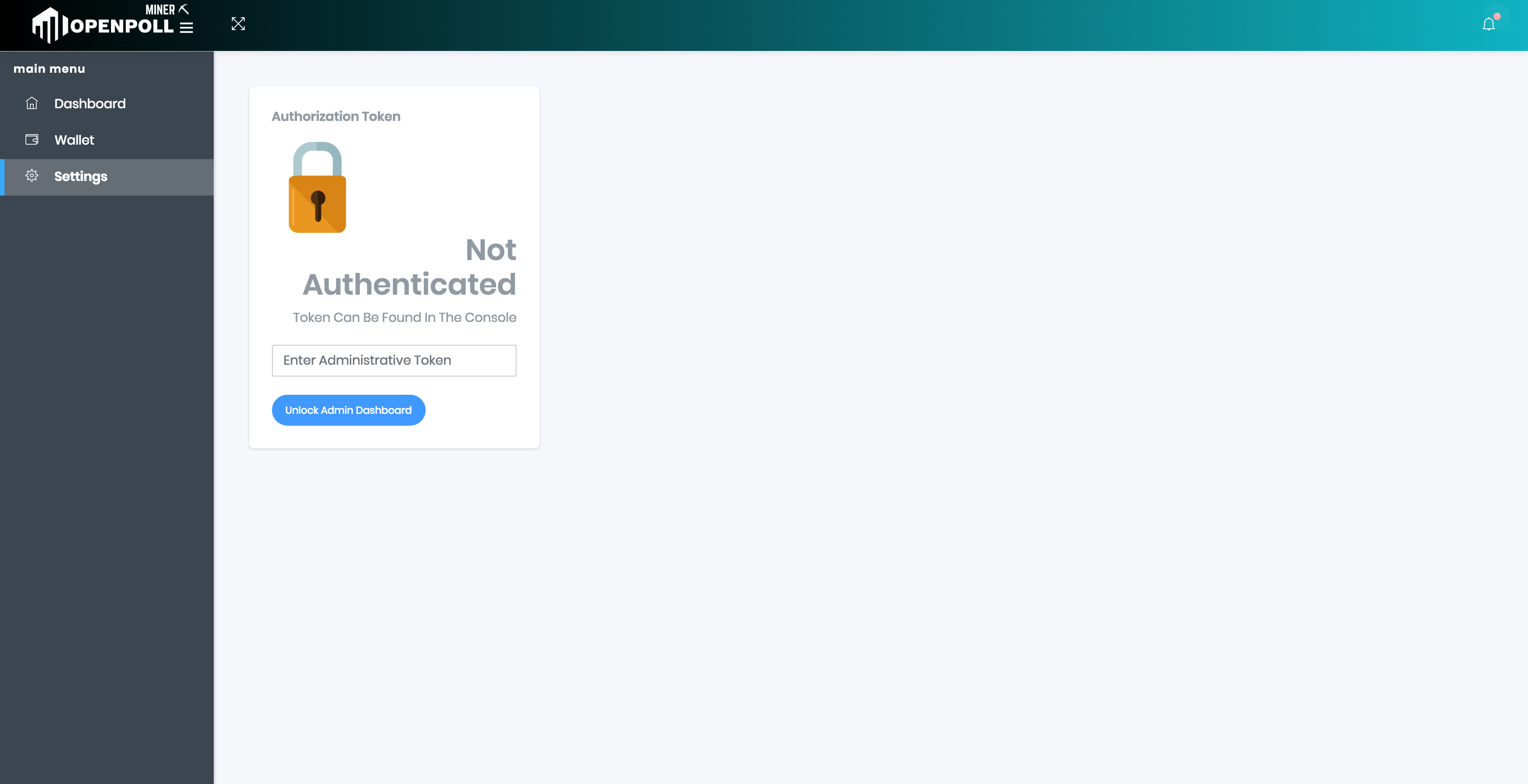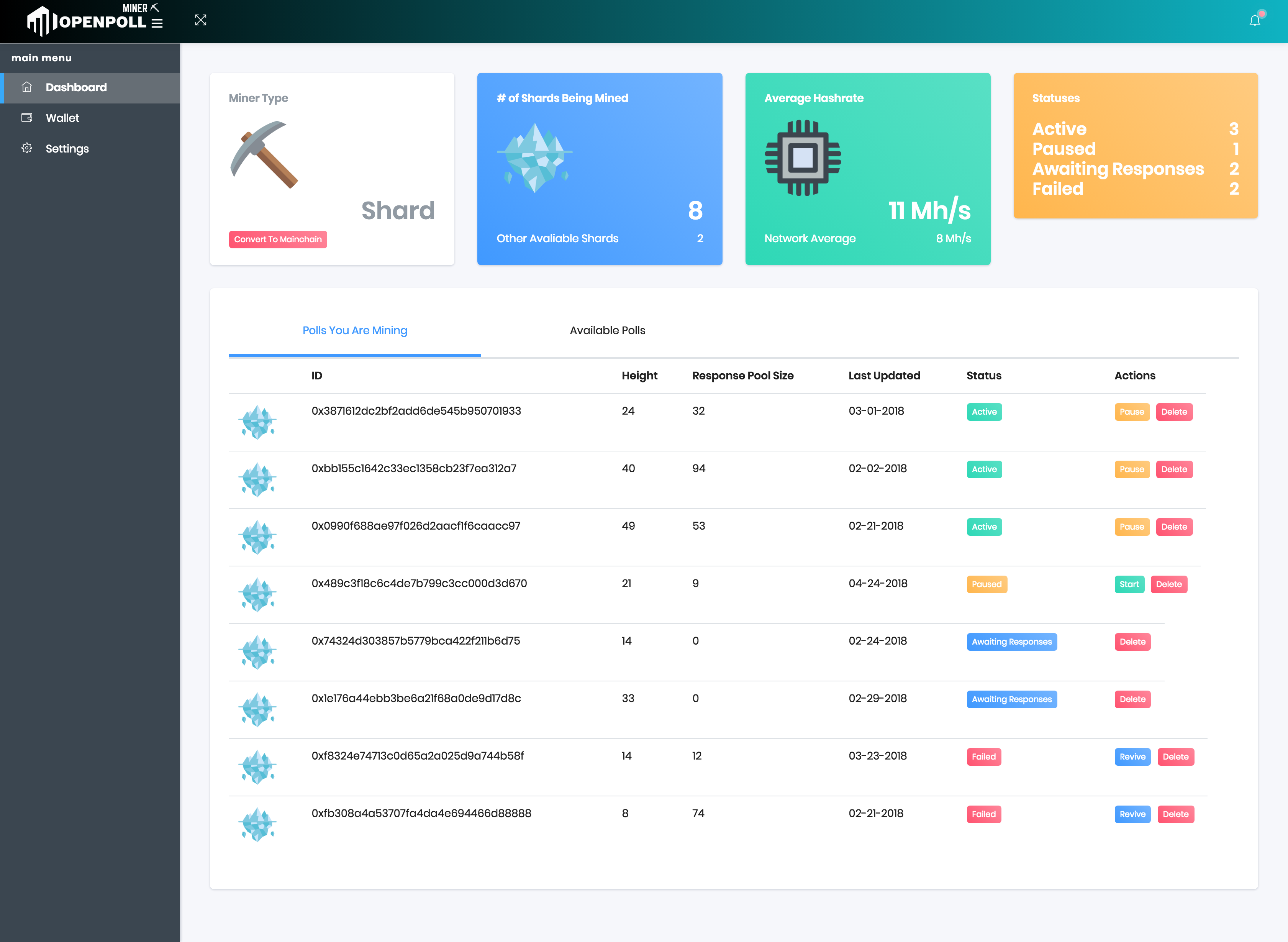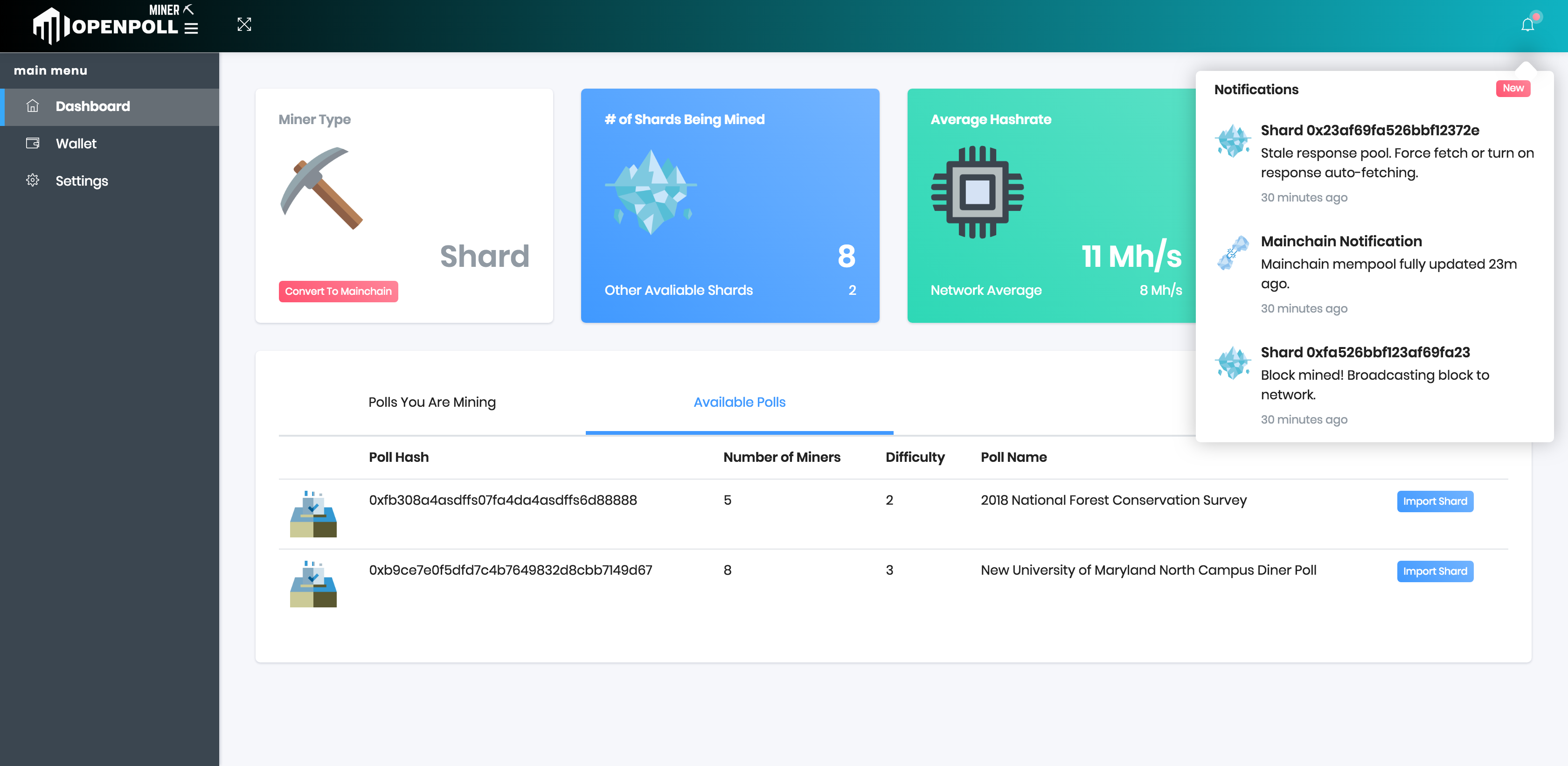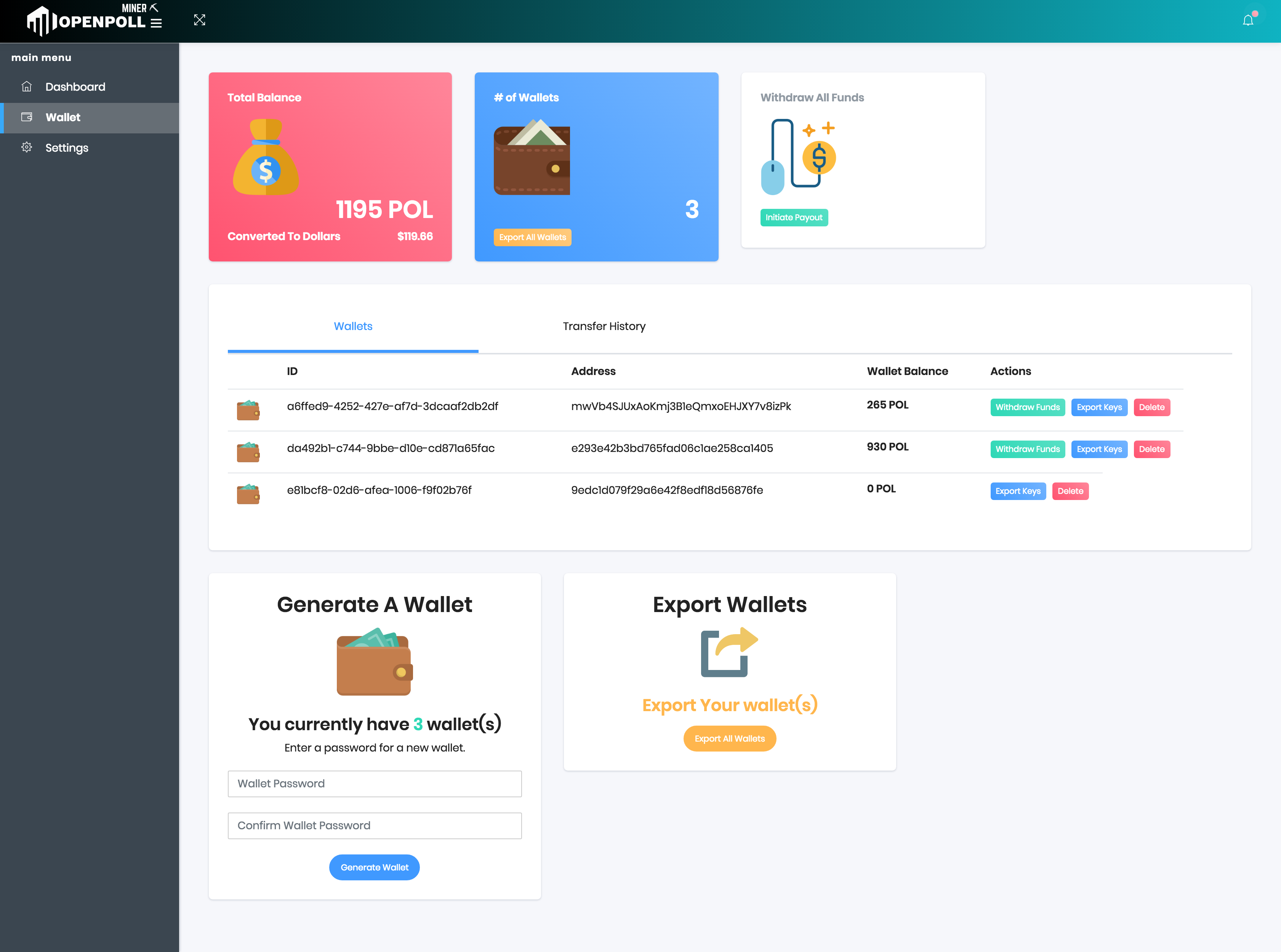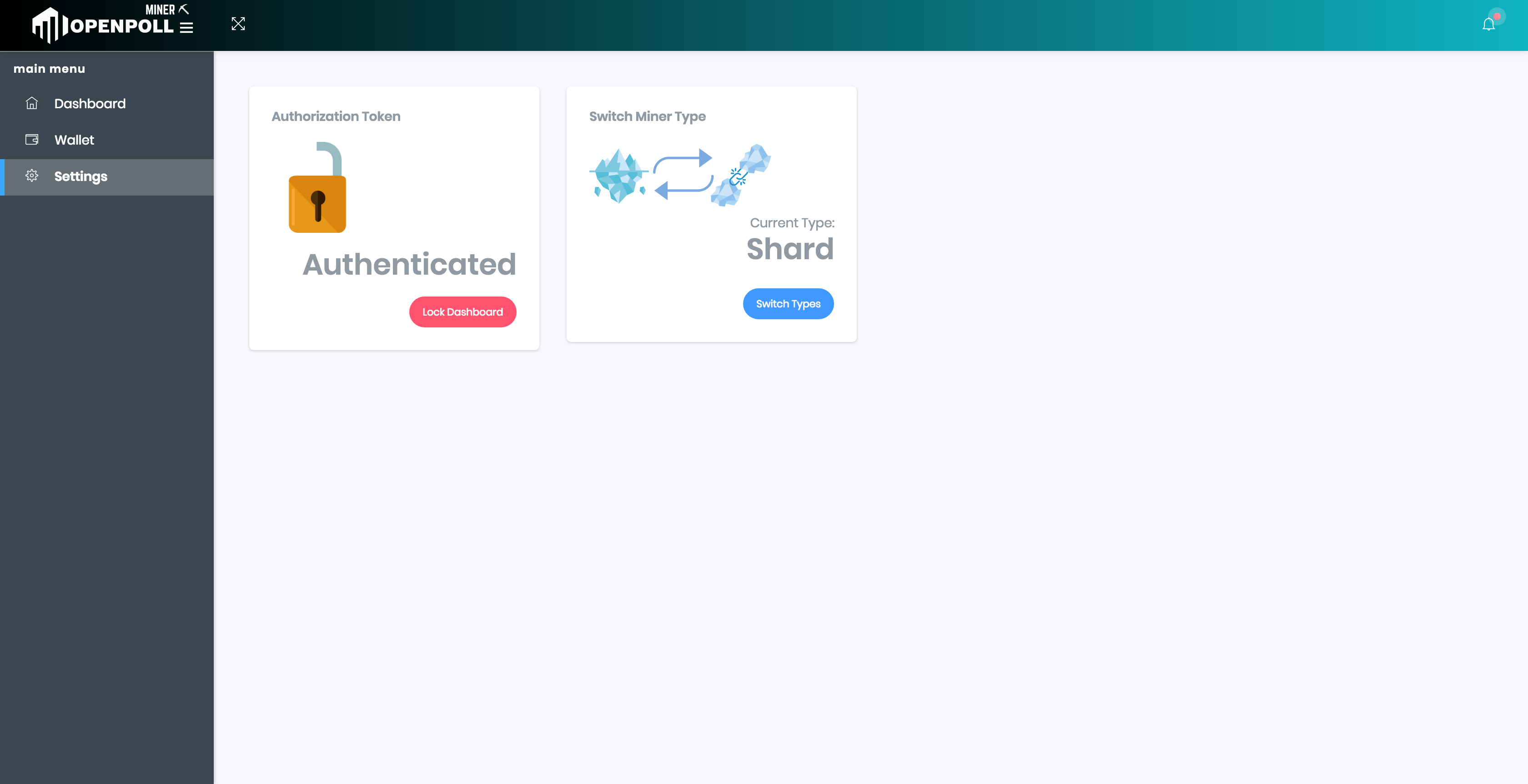Purpose: The miner interface is an Angular 5 frontend Single Page Application (SPA) that provides miners access to the underlying functionality and elements of the mining app that will allow them to perform their mining tasks, monitor critical metrics, and manage their wallets. This page will outline the basic endpoints (at least for now) that the mining application will contain to respond to frontend events. Endpoints will be prefaced by '/admin/' and be secured by a token.
Locked (no token entered yet)
Home Dashboard (Shard Mining Tab)
Home Dashboard (Available Polls)
Note: The Angular application will fetch this tab's data from the facilitator API and not have to talk to the underlying mining application instance therefore no endpoint covers the data found in this tab.
Wallet Management Tab
Settings
Repo: https://github.com/opoll/openpoll-miner-interface
Note: This repo will end up embedded in the main mining application in a folder like 'client/' then be served to the client and from there communication will take place through HTTP with token secured endpoints.
When the Angular app is first served to the client the server will generate and store a token called adminAuthToken in LevelDb. The toke will be generated like so:
Base64( random_alphanumeric(32) + ";" + Miner_IPAddress + ";" + Miner_Port )
Progress goes as follows:
- User loads miner application
- Miner application checks leveldb for auth token (the token itself, not the base64 containing the IP and Port, just the code). if one exists, it uses that one. if none exists, it generates a new code and stores it.
- Miner generates an authorization code which is
token;ip;portbase64'd and then prints this to console. this code can by copy-pasted into the angular GUI to access the miner. - Angular GUI sends the token as the authorization in all requests.
At no point in the flow is there automatic authorization. The angular app stores the token locally and during first launch, the user will have to get the token / authorization code from the console to access the admin interface.
This token will be be printed to the CLI and embedded in the Angular application upon it being served.
If invalid the mining application will reject the request with a 401 Unauthorized status code (this will never happen to the actual miner using their dashboard since they will know/have the correct token at all times). If valid the miner will respond normally with the data the Angular app desires.
The adminAuthToken will consist of a 32 byte hex string concatenated with the miner's address as well as the port of communication (each element separated by a semicolon ";")
Token before conversion to Base64:
68b468604e675e11e7ab3c09c55bd247b63b196fd7c8983aa375f5fc43253c31;17.8.243.140;9011
Token after conversion to Base64 and appending of 'Bearer:' label:
Bearer: NjhiNDY4NjA0ZTY3NWUxMWU3YWIzYzA5YzU1YmQyNDdiNjNiMTk2ZmQ3Yzg5ODNhYTM3NWY1ZmM0MzI1M2MzMTsxNy44LjI0My4xNDA7OTAxMQ==
The Angular data service that makes requests to the mining application will set its request Authorization header roughly like so with each request:
import { Http, Headers, RequestOptions } from '@angular/http';
const token = 'NjhiNDY4NjA0ZTY3NWUxMWU3YWIzYzA5YzU1YmQyNDdiNjNiMTk2ZmQ3Yzg5ODNhYTM3NWY1ZmM0MzI1M2MzMTsxNy44LjI0My4xNDA7OTAxMQ==';
someServiceGetRequest(token){
const httpOptions = this.getAuthHttpOptions(token);
return this.http.get(url, httpOptions)
.map(res => res.json());
}
getAuthHttpOptions(tokenString): RequestOptions{
// Create auth string
const auth = `Bearer: ${tokenString}`;
// Set headers
let headers = new Headers();
headers.append('Authorization', auth);
// Set http options
let httpOptions = new RequestOptions();
httpOptions.headers = headers;
return httpOptions;
}
And the mining application middleware will validate the header like so:
const authHeader = req.get('Authorization'); // Extract Authorization header
if (!authHeader) {
// Auth header not found. Reject request.
}
// Header found. Isolate.
const tokenSplit = authHeader.split(' ');
const token = tokenSplit[1]; // Removes 'Bearer: ' from authHeader string
const adminAuthToken = // Fetch token held in LevelDb sync or async.
// Compare isolated token to what is in mining app instance's LevelDb.
if(token != adminAuthToken){
// Auth token is incorrect. Reject request.
}
// At this point token is valid. Call next(). Endpoint access granted.
next();
Non-Restriceted Admin Endpoints
POST /admin/auth
Checks whether the token value passed in the request body is a valid admin auth token. This endpoint is limited to TOKEN_CHECK_LIMIT tries to prevent a brute forcing of the token.
GET /admin/chains/shards
This will return an array of general data on the shards that the miner is working on to populate the initial home dashboard view with.
Response
{
shardEntries: [
{
id: '74324d...1b6d75', // Id of chain. Hex id for a shard or 'main' for mainchain
height: 15, // Height of the chain
respPoolSize: 32, // the size of the response pool maintained locally associated with this shard
lastUpdated: '02-31-2018', // Date this chain was last synched with the network
status: 'Active' // Chain status. 'Active', 'Paused', 'Awaiting Responses', or 'Failed'.
// Active: The chain is being mined on
// Paused: The chain is ready to be mined on but is currently idle
// Awaiting Responses: Chain imported but response pool empty. Awaiting responses.
// Failed: A fatal error occurred. The shard's mempool and chain must be refetched.
}
]
}
GET /admin/chains/mainchain
This will return an general data on the mainchain that the miner is working on to populate the initial home dashboard with.
Response
{
mainchainEntry: {
height: 15, // Height of the chain
lastUpdated: '02-31-2018', // Date this chain was last synched with the network
status: 'Paused' // Chain status. 'Active', 'Paused', or 'Failed'.
// Active: The chain is being mined on
// Paused: The chain is ready to be mined on but is currently idle
// Failed: A fatal error occurred. The shard's mempool and chain must be refetched.
}
}
GET /admin/chains/shards/{shardID}/event?action=start
Starts the shard with the provided shard ID.
GET /admin/chains/shards/{shardID}/event?action=pause
Pauses the shard with the provided shard ID.
GET /admin/chains/mainchain/event?action=start
Starts the mining on the mainchain.
GET /admin/chains/mainchain/event?action=pause
Pauses the mining on the mainchain.
DELETE /admin/chains/shards/{shardID}
Deletes the specified shard from the miner's mining pool. Mining is shut down for the shard and the db is wiped of any entries for the specified shard. The node's working status is potentially broadcasted.
DELETE /admin/chains/mainchain
Clears the mining pool for the mainchain (both txns and completed shards). Mining is shutdown for the mainchain and the db is wiped of entries for the mainchain. The node's working status is potentially broadcasted.
GET /admin/wallets
This will return an array of general data on the wallets that the miner holds to populate the wallet component view with.
Response
{
wallets: [
{
id: 'a6ffed...2db2df', // The id of the wallet
address: 'mwVb4SJUxAoKmj3B1eQmxoEHJXY7v8izPk',
balance: 265 // Wallet balance in POL
}
]
}
GET /admin/wallets/{walletId}/event?action=exportKeys
Returns the private and public key pair for the wallet with the specified ID.
DELETE /admin/wallets/{walletId}
Deletes the specified wallet from LevelDb and the keys associated with it. Double user confirmation on the frontend will be implemented as this is a drastic action.
GET /admin/wallets/event?action=exportWallets
Exports the complete information of all of the miner's wallets. This is a sensitive route so it is key that token rotation protects this endpoint.
POST /admin/wallets
Request to create a new wallet. If token is valid and password as well as confirm password match, a new wallet is created with one address. The response will contain general information on this wallet to populate the interface with.
Request Body
{
password: f2cc7084f422c2dfc161db19e
}
Response
{
wallet: {
id: 'a6ffed...2db2df', // The id of the new wallet
address: 'mwVb4SJUxAoKmj3B1eQmxoEHJXY7v8izPk',
balance: 0 // Wallet balance in POL
}
}
GET /admin/notifications
Gets all of the miner's notifications. Notifications will be emitted from the event factory upon a calling module using the sendNotification method.
DELETE /admin/notifications?cutoff={cutoffEpochDate}
Deletes all notifications falling behind a specified cutOff epoch date.
DELETE /admin/notifications/{notificationId}
Deletes a specific notificationId passed in as a path parameter
In order to keep the dashboard data live and fresh, the miner will be emitting websocket events with the appropriate data for the event. The miner will simply be using the eventFactory module that abstracts away the actual event names and boilerplate websocket code to make the event emission work.
Here are some events that are covered by the eventFactory module currently:
When calling the sendNotification method a programmer should pass in a JS object formatted like so:
the notification someone will pass in is in this format
{
type: string; // Either "shard", "mainchain", or "general"
title: string; // The notification's title
message: string; // The notification's message
}
The real notification object looks like this in the db:
{
id: string; // Random 8 byte hexadecimal ID
type: string; // Either "shard", "mainchain", or "general"
title: string; // The notification's title
message: string; // The notification's message
dateCreated: number; // Epoch date the notification was created
}
But the sendNotification function takes care of time-stamping the notification (dateCreated) as well as assigning it an id (id) for record keeping purposes.
